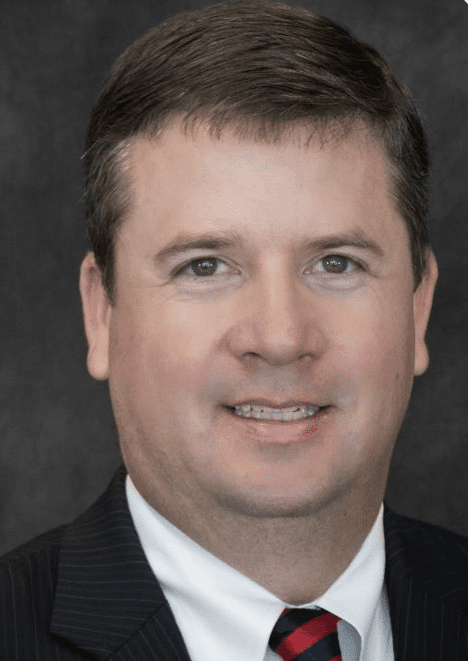[ad_1]
Teacher shortage has become a top issue again this year, as school districts everywhere are working harder than ever to recruit new teachers and retain the ones they currently have. The Discovery Education team interviewed Dr. Andrew Houlihan, Superintendent of North Carolina’s Union County Public Schools, to hear his thoughts on teacher recruitment, retention, and the success he’s seen so far in his district’s efforts to tackle this crisis.
What was your personal inspiration to become an educator? What continues to drive you today?
I grew up in a household of educators—my mom was a counselor and my dad was a teacher, principal, and a superintendent—so I knew that world. I also swore I would never be a superintendent.
When I was in high school, I took a class called “Peer Helpers,” where I tutored elementary kids at a Title I feeder school. I really enjoyed it, and at the same time was exploring options for college. Back then, we had the North Carolina Teaching Fellows Scholarship, which was basically a full ride to a significant number of state universities. I was awarded that scholarship, and after graduating, worked in Wake County as a second-grade teacher at a Title I school.
In fact, much of my career has focused on, and been devoted to, our neediest kids. Whether they’re in a Title I environment or not, making sure that, from an equity and access standpoint with programming, innovation, resources, or funding, that we’re doing all that we can each day to ensure that all our kids receive a high-quality education.
That’s really what drives me every single day—making a difference, making an impact, and hoping that our students matriculate, then graduate, beyond prepared for success and life.
As a leader in your district, what effects of the teacher shortage have you noticed on your students and staff?
When you’re missing individuals in classrooms due to vacancies, your principals have to be very creative on how we ensure our kids are safe and continue to receive a high-quality education.

Primarily we have seen an impact with the North Carolina K-3 class size law. By law we are required to put our teachers in our K-3 buildings first, then we allocate staff to grades 4-12. Because we’re a growing district and have vacancies, we often must combine classes or have larger class sizes. In some cases, like during the pandemic, we had to have classes in the auditorium or the cafeteria, and really expand the reach of our highly effective teachers to teach more kids.
We’ve also seen an impact with the number of available substitute teachers. We were at about a 33% fill rate earlier in the year, so we made the decision to hire a third-party staffing company in December. Now we’re at about a 75% fill rate, so we’ve made some growth there.
This is a situation where we need trusted adults who are not only certified to teach and who want to teach, but who can also keep kids safe. We’ve been fortunate and safety has been a huge priority, but that is always a big concern and one we have to recognize.
Are there teacher recruitment strategies you’ve tried, or are currently using, that made a difference in bringing new teachers into your district?
The biggest push we’ve made is building a relationship, as a superintendent and as an HR staff, with deans of colleges of education in our region and state. We need to proactively get in front of future teachers when they’re a freshman or a sophomore, before they’re deciding where they might want to go teach. There are several local universities that bring us many of our teachers when they graduate, and these relationships have been a great help to our recruitment efforts.
Another strategy I’ve used before (sort of a secret recipe) is using your state or district compensation to your advantage. North Carolina certainly has a ways to go to advance teacher pay, but we have found some success in recruiting teachers from areas where our compensation plan is stronger than their local school district or state’s salary schedules.
A change in recruitment that resulted from the pandemic is how job fairs have evolved. With the pandemic, everyone went virtual, and became used to that. As a result, we’ve noticed in the past couple of years that our enrollment for those fairs has declined. However, our virtual recruiting efforts, depending on the college or university, have brought in higher attendance numbers. That’s a pivot we’ve had to figure out and, while we haven’t figured it out completely, it’s another recruitment strategy we’re capitalizing on.
How has teacher recruitment changed over the course of your career? How has today’s educator changed compared to when you first started in education?
We have to recognize that the generation of 22-24 year-old teachers have different perspectives than the ones from when I went through college and graduated. They’ve experienced life differently, gone through a global pandemic, and are likely much more adept and adapt with technology. Recognizing the strengths of those perspectives, but also the gaps, of those who come into teaching is important.
We also must figure out how to partner better with our higher ed agencies to develop other alternatively licensed pathways through which we can recruit.

One strategy we’ve used to address this is our daily in-school tutoring program. We launched this program in our lowest performing schools before the pandemic, and we’ve seen a good pipeline of non-certified individuals that pass a series of assessments and credentials, to then become full-time teachers over the course of a year or two. The recruitment, we must recognize, doesn’t necessarily come from just a college anymore—there are other entities that we have to recruit from.
“The recruitment, we have to recognize, doesn’t necessarily come from just a college anymore—we have to find other outlets for recruiting new teachers.”
Dr. Andrew Houlihan, Superintendent of Union County Public Schools
Tweet
Have you been working with high schools to introduce younger students to the field of education?
We announced in February a new program called Teach UCPS. It is a targeted effort for both current employees and students. Beginning in 9th grade, there are three pathways:
The first pathway is an aggressive associate degree that starts in 9th grade. Students in this program work through a course sequence with our local community college and their high school, and they graduate with a two-year associate degree at the same time as their high school diploma. Next, students take the “Gateway to Wingate Scholarship” to finish their bachelor’s degree at Wingate University for only $2,500 a year. Once they graduate from Wingate, they are hired to teach in UCPS.
The other two options are based on our Academy model, where beginning in 10th grade, students can take a series of courses and graduate from high school with 7 college credit hours. They can choose to attend our local community college for free afterwards, and are eligible to then access the same scholarship to attend Wingate University.
We’re also currently working on raising scholarship money so students can graduate from Wingate entirely debt free, and then in return, teach in UCPS for a minimum of three years in a Title I school or a minimum of four years in a non-Title I school. We’re really excited about this, and are introducing it to our 8th graders, as well as high school students, who might want to be part of the Academy model. This program is a longer-term investment—we aren’t going to see any return on it for at least 3-4 more years, but it’s an innovative strategy that we believe will have huge benefits!
Why is retaining teachers past the first five years of their career important? How does it affect student success?
There’s plenty of research that explains the benefits of how experienced teachers impact student achievement. These studies show that the longer you’re in the teaching profession, the more you grow and adapt—making you an expert. I still think that research holds true today and that there is significant value in experience. I also believe retaining new teachers hasn’t changed either: our teachers need support. They can’t work in silos or in isolation.

The need for new teacher support has become much more important as we feel the effects the pandemic has had on education. Teachers are now expected to start their first year knowing how to teach reading skills, know their content, and simply know what a 10-year veteran teacher to know. These skills are not going to be gained by new teachers without support from their school district, other teachers, and their school site leadership.
A few years ago, UCPS funded our Beginning Teacher Support Team, so we have an in-house division that does nothing but work with our teachers in their first three years. They’re coaches, not evaluators—they are purely there to observe, give feedback, and work with leadership for further support. They help create structures like partnering new teachers with mentor teachers and providing targeted professional development. Those first three years are critical, but it’s a balance of offering new teachers support while not overwhelming them.
Retention is important when it comes to student achievement and growth, but it’s also important from an economic standpoint. When teachers leave, starting over with new hires impacts a district’s budget, support plan, and slows down growth from the prior year’s work. We like to invest in our employees, but we need to see those investments pay off. The longer you stay with us, the bigger the investment and the payoff we’re all going to see!
What advice can you offer to other education leaders who are trying to retain their teachers?
I believe that teachers like to stay in a district for the same reasons today as they did 20 years ago, when research was put together on retention. Here they are, in order:
- They want to have a highly effective leader. The effectiveness and quality of the building principal makes a huge difference.
- They want professional development opportunities. They want the chance to grow in their craft and to get better.
- They want leadership opportunities. What can you do as a building leader or a district leader to ensure that your teachers are having leadership opportunities at both the district and school levels? That is incredibly important.
- They want fair compensation—leaders should be advocating at the local, state, and federal levels to increase teacher pay, supplements, and stipends. A lot of people say that teachers won’t come into the profession because of pay, and that is certainly part of the reason, but I don’t believe it’s the top reason.
One last piece of advice: we can’t have our own teachers telling our students to avoid the teaching profession. Building a culture where educators are seen as professionals, decision makers, and leaders, and encouraging our youth to enter the profession, takes hard work at the district and school levels. We continue to strive for this type of environment every day!
How are teachers in your district involved with high-level decisions? How is their feedback gathered and used?
I have stakeholder structures for feedback collection, with advisory councils that meet with my cabinet staff and me at least once a quarter. We have councils for principals, elementary school students, high school students, parents, and teachers to gather with their peers, discuss relevant topics, and share feedback.
Our teacher advisory council is made up of 53 teachers, one teacher elected from each school. When our teacher advisory council meets, they prepare and send their questions before our meeting date. During our meetings, we spend some time elaborating on those questions if there are any concerns, but most of our time is spent gathering feedback on a problem of practice, a policy, or an upcoming decision.
One recent topic was our budget process—we always ask our teachers to prioritize what we should advocate for in our budget. At our upcoming teacher advisory council meeting, we’re going to break the members up and ask for feedback on our recently launched portrait of a UCPS graduate. We’re going to dive into what these attributes look like in the classroom so we can then implement curriculum resources that support teachers in helping students build these skills.
Whether it’s policy, funding, or whatever the topic is, we always want to gather feedback from our teachers because we value their expertise—they’re the ones with boots on the ground.
Dr. Andrew Houlihan, Superintendent of Union County Public Schools
Tweet
Do you find that in these different advisory councils, the issues or concerns that are brought up are similar?
Yes! It’s interesting to hear a 5-year-old student and an 18-year-old student advocate for the same things. We have a common topic that our cabinet selects, and we ask all the councils the same questions. Next, we figure out the trends and triangulate the data across these different groups to identify the key points. More times than not, we get a lot of overlap!
How could local and state education leaders help your teacher retention and recruitment efforts?
There are three major areas that come to mind:
- We need to figure out a way to better incentivize our youth to enter the teaching profession. We’re doing all we can to innovate locally, but having some statewide or federal assistance would certainly help school districts create a more robust pipeline of new educators.
- Going back to the compensation discussion, we need to pay our teachers a professional wage, not just a livable wage. Teacher salaries are often decided by leaders at the state level, so they can make a worthy change there.
- From a policy standpoint, any additional flexibility we can have with teacher licensure would be helpful. North Carolina charter schools have a tremendous amount of flexibility with that, and in the public school setting we do not. In my opinion, that same licensure flexibility should be offered to all our schools.
Those are some of the top ways our state leaders can help us, but we’re all proud of the work we’ve done at UCPS. We’ve historically been the highest performing large district in the state, and we work hard every day at maintaining that high performance. At the end of the day, we need to recruit and retain as many people as possible in this profession, which takes hard work—a lot of marketing, education, and creativity.
When it comes to recruiting and retaining teachers, school districts are finding ways to get creative and keep up with the challenges that pop up along the way. While the details of each school district’s staffing concerns will be unique, learning the steps other educational leaders are taking to tackle teacher recruitment and retention can help refresh strategies. The bottom line for finding teachers comes down to providing a high-quality education for students, something every student deserves!

Andrew G. Houlihan, Ed. D
Dr. Andrew G. Houlihan is currently in his seventh year as Superintendent of the Union County Public Schools. In 2022, Education Week recognized him as a national Leader to Learn From for his strategic leadership, he was named the 2022 Superintendent of the Year for the Southwest Regional Alliance (Region 6), and he was a finalist for the North Carolina State Superintendent of the Year. Prior to joining UCPS, he served in numerous roles within the Houston Independent School District and served in various leadership roles in the Austin Independent School District.
Union County Public Schools is the sixth-largest public school system in North Carolina. It serves approximately 41,000 students at 53 schools and has approximately 5,000 staff members. Known as a leader in academics, UCPS offers a wide variety of coursework to its students, with a long-term goal of ensuring all students are equipped to succeed in college, career and life.
Learn more about retaining your best educators with DE’s new eBook on teacher shortage!
The post A Positive, Proactive Approach to Handling Teacher Shortage appeared first on Discovery Education Blog.
[ad_2]
Source link
